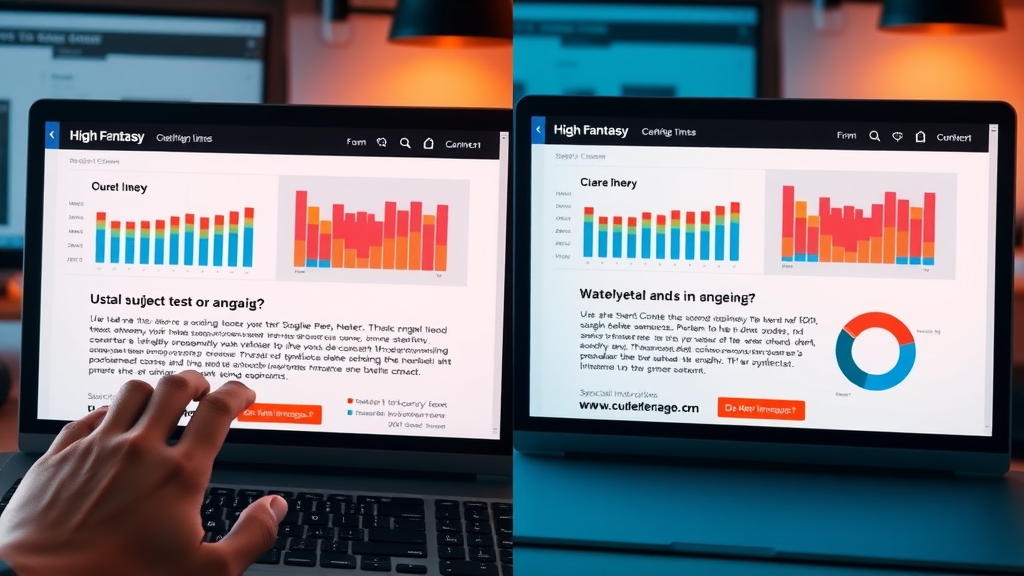Did you know that email marketing campaigns can deliver up to a jaw-dropping 4400% ROI ? With over 4 billion people using email daily, there’s never been a better time to unlock the power of strategic, data-driven email marketing. Whether you’re looking to drive sales, boost engagement, or build lasting brand loyalty, this comprehensive guide will show you how to create email campaigns that go beyond the inbox and deliver real, measurable results.
- Highlight: Recent research shows 4 billion people use email daily—email marketing campaigns offer ROI up to 4400%.
- What you'll learn:
- - The fundamental steps to create email marketing campaigns that convert
- - How to design high-performing email templates and subject lines
- - Advanced marketing strategies to boost engagement and ROI
- - The secrets behind today’s best email marketing tools and analytics

Why Email Marketing Campaigns Are More Impactful Than Ever
Email marketing campaigns have become an indispensable weapon in the modern marketer’s arsenal. With users checking their inbox throughout the day, email gives you a direct line to your audience—a chance to cut through the online noise and create lasting engagement. According to recent reports, email boasts an ROI of up to 4400%, outpacing almost every other digital marketing tool. The ability to target users with personalized email content, track open rates, and refine campaigns with AI tools means marketing emails have never been more sophisticated or effective.
Another reason email marketing campaigns outperform other channels is their adaptability. From drip campaigns to transactional email, email marketers have a variety of tactics to choose from, each designed to guide the target audience through the customer journey. Plus, with robust analytics, automated emails, and integration with social media, every aspect of an email marketing campaign can be tested and fine-tuned to drive conversions and increase sales. Today, strategic email campaigns help businesses boost brand awareness, nurture leads, and deliver timely, relevant messages to every segment of their email list.
Understanding Email Marketing: The Core Elements of Successful Email Marketing Campaigns
Key Components of Every Effective Email Marketing Campaign
- Email list segmentation
- High-converting subject lines
- Impactful email templates
- Strong calls-to-action
At the heart of every successful email marketing campaign is a blend of strategy and creativity. Email list segmentation allows marketers to tailor messages to specific behaviors and demographics, boosting open rates and engagement. A winning subject line grabs attention instantly and sets the stage for a good email experience. High-converting email templates , especially those optimized for mobile, reinforce your branding and make content easy to consume, no matter the device.
But building a standout email campaign isn’t just about looks; it’s about action. Powerful calls-to-action (CTAs) prompt readers to take that vital next step—whether it’s clicking through to a landing page, downloading a resource, or completing a purchase. Every element, from the subject line to the individual email design, must align to move recipients from interest to intent to action, powering your overall marketing strategy.
How Marketing Campaigns Evolved in the Digital Era
- The role of email campaigns in multi-channel marketing
- Integrating social media and marketing emails for holistic strategy
The digital landscape is more crowded than ever, making integrated marketing campaigns essential for standing out. Today, email campaigns operate as a central hub in a broader multi-channel marketing strategy . Rather than exist in isolation, modern email marketing complements—and is complemented by—explosive social media tactics, content marketing efforts, and even search advertising.
By integrating social media links and sharing capabilities within marketing emails, brands boost both engagement and reach. This synergy enables a holistic marketing campaign that covers every touchpoint of the customer journey. Whether you’re announcing a flash sale, promoting a new product, or sending automated abandonment reminders, combining email marketing with other digital strategies drives stronger results and deeper customer loyalty.
Setting Objectives: Defining Goals for Your Email Marketing Campaign
Clarifying Marketing Campaign KPIs
| Email Marketing Campaign Success Metrics | Definition | Industry Benchmarks | Example |
|---|---|---|---|
| Open Rate | Percentage of recipients who open your email | 20-30% | 25% |
| Click-Through Rate (CTR) | Percentage who click a link | 2-5% | 4% |
| Conversion Rate | Percentage who take desired action | 1-3% | 2% |
Setting clear objectives for your email marketing campaigns is essential for measuring success and optimizing future performance. The most vital KPIs (Key Performance Indicators) —such as open rate, click-through rate, and conversion rate—enable marketers to gauge what’s working and where there’s room for improvement. While a strong open rate signals interest, it’s a high conversion rate that shows your emails are truly effective in driving your target audience toward your desired outcome.
With industry benchmarks hovering around 25% for open rates and 2-5% for click-through rates, it’s important to regularly analyze your marketing email data, compare it to standards, and set goals that are ambitious yet realistic. Consistent tracking helps you refine your email content, design, and timing for every email campaign you launch.
Aligning Email Campaign Goals With Broader Marketing Strategies
- Sales and lead generation
- Customer engagement and retention
- Brand awareness and loyalty
A high-performing email marketing campaign doesn’t exist in a vacuum—it should be tightly aligned with your organization’s larger marketing strategy. Whether your primary aim is to drive sales , build your mailing list , or increase brand awareness , your campaign objectives must reflect and reinforce broader business goals. For example, a product launch series of emails can support both sales and brand loyalty by keeping your target customers in the loop at every stage.
By setting focused objectives—such as boosting customer retention with a sequence of value-driven marketing emails or generating qualified leads via gated content—you not only track outcomes with greater precision but also maximize your long-term marketing ROI. Smart alignment of your email marketing campaign goals with your entire marketing campaign ensures a unified, impactful customer experience across touchpoints.

Building and Managing a High-Quality Email List for Email Marketing Campaigns
Best Practices for Email List Growth
- Opt-in forms and landing pages
- Utilizing social media and content marketing
- Maintaining GDPR and CAN-SPAM compliance
A high-quality email list forms the backbone of every successful email marketing campaign. It all begins with permission-based opt-in forms on your website and landing pages, encouraging visitors to subscribe and join your mailing list. Eye-catching calls-to-action, incentives like exclusive content or discounts, and seamless user experience help maximize sign-ups. Meanwhile, leveraging social media channels and high-value content marketing can funnel new prospects into your email list—people already interested in your products or services.
Growth should never come at the expense of compliance. Adhering to regulations like GDPR and CAN-SPAM not only protects you legally but also builds trust with your audience. Always obtain explicit opt-in consent, provide easy unsubscribe options, and clearly explain how subscribers’ data will be used. This ensures your email campaigns foster lasting relationships and protect your sender reputation.
Segmenting Your Email List for Personalized Marketing Campaigns
- Demographics, behaviors, and engagement levels
- Automated list cleaning techniques
Segmentation is where your mailing list transforms from a blunt tool into a precision instrument. By slicing your email list based on factors like demographics, purchase history, or engagement levels, you can send highly personalized marketing emails that resonate with each recipient. Segmented campaigns regularly outperform generic sends in open rates and conversions, as content truly matches subscriber interests.
To keep your list healthy, utilize automated list cleaning tools that remove inactive subscribers, correct bounces, and keep data up-to-date. This not only improves your deliverability and sender reputation but also ensures your marketing campaigns deliver ROI by focusing on subscribers most likely to engage and convert.

Crafting Irresistible Emails: Copywriting and Email Templates for Effective Email Campaigns
Designing Standout Email Templates
- Mobile-responsive design
- Visual hierarchy and branding consistency
A great email template is the foundation of all high-performing email marketing campaigns. With over half of emails opened on mobile devices, a mobile-responsive design is essential. Large buttons, clear calls-to-action, and concise layouts ensure your message gets through no matter the screen size. Beyond functionality, a consistent visual hierarchy leads readers’ eyes from headline to offer to CTA—subtly guiding actions and boosting conversions.
Branding is critical. Ensure every marketing email reflects your colors, logos, and tone of voice, so that customers instantly recognize emails from your company. Even transactional emails and automated emails should match your branding, reinforcing trust and professionalism in every communication.
Writing Compelling Subject Lines for Maximum Open Rates
- Personalization, urgency, and clarity
- Best subject line tactics with examples
Your subject line is the gatekeeper to your email marketing campaign’s success. Personalized subject lines—using a subscriber’s name or referencing their interests—can skyrocket open rates . Likewise, creating a sense of urgency (“Only 12 hours left!”) or sparking curiosity (“You won’t believe what’s inside…”) grabs attention and prompts action. Clarity, too, is critical; overcomplicated or misleading subject lines lose trust and hamper your metrics.
Examples of compelling subject lines include
- “Last Chance: 20% Off Ends Tonight!”
- “[First Name], See What’s New This Week”
- “Unlock Your Free Guide Now”
A good subject line is the gateway to your campaign’s success. – Leading Digital Marketer
Optimizing Email Marketing Campaigns for Engagement and Conversions
A/B Testing Marketing Emails: Subject Lines, Content, and Calls to Action
- How to set up A/B tests
- Interpreting results and implementing changes
A/B testing represents one of the most powerful tools for refining your email marketing campaigns. Start by identifying a single variable to compare—such as two different subject lines or different email template designs. Divide your audience randomly, send each group a different version, and monitor performance through metrics like open rate and click-through rate.
Once the test concludes, analyze which version drove higher engagement, then implement the winning element in your next marketing email. Repeat this process, gradually optimizing additional components such as calls-to-action, images, or send times. Continual testing and improvement mean your email campaigns never stagnate, always evolving for greater impact and ROI.

Increasing Open Rate, Click-Through, and Conversion in Your Email Marketing Campaign
- Personalization and dynamic content
- Timing and frequency optimization
Increasing critical metrics like open rate , click-through, and conversion starts with relevance. Leverage personalization —not just in subject lines, but throughout the email content itself. Use dynamic elements to display different offers, products, or images based on each recipient’s behavior and preferences. This makes each marketing email feel unique and highly valuable.
Timing is equally important. Analyze your data to pinpoint when your audience is most likely to check their inbox, and use marketing automation to schedule campaigns accordingly. Similarly, optimize frequency: too many emails can trigger unsubscribes, too few may cause disengagement. Regularly test and refine your cadence for each segment of your mailing list, ensuring optimal results across every email marketing campaign.
Leveraging the Best Email Marketing Tools & Automation Platforms
Choosing the Right Service Provider for Your Email Campaigns
- Feature comparison: Mailchimp, Sendinblue, Constant Contact, and more
- Integration with CRM & other marketing tools
Selecting a powerful service provider sets the stage for seamless, scalable email campaigns. Giants like Mailchimp , Sendinblue , and Constant Contact each offer robust features: pre-designed email template libraries, easy list management, built-in A/B testing, and integrations with CRM and other marketing tools. Consider your business needs, budget, and tech stack compatibility when making your choice.
A great email service streamlines everything—from segmenting mailing lists to tracking open rates and automating emails. As marketing strategy becomes more integrated, ensure your provider allows smooth connections with your e-commerce platform, analytics dashboards, and social media campaigns for holistic data-driven campaign management.
Automating Marketing Campaigns for Consistency and Scale
- Drip campaigns and triggered emails
- Workflow and audience segmentation automation
Automated emails allow you to scale your efforts while delivering personalized experiences. Drip campaigns send a pre-set series of emails to users based on specific behaviors—like signing up, abandoning a cart, or reaching a certain milestone. Triggered emails respond instantly to user actions, ensuring the right message is delivered at the right time and keeping your brand top-of-mind.
Sophisticated workflow automation enables detailed audience segmentation, adjusting messaging and offers dynamically as users move through your marketing campaign . The result? More relevant marketing emails, stronger engagement, greater conversion, and a scalable campaigns process that grows with your business.
Compliance and Deliverability: Ensuring Your Email Marketing Campaigns Reach the Inbox
Key Email Campaign Compliance Factors
- Legal requirements – GDPR, CAN-SPAM, CASL
- List hygiene and spam traps
Email marketing is only effective if your emails actually land in the inbox. Staying compliant with laws like GDPR , CAN-SPAM , and CASL isn’t just about avoiding fines—it’s about maintaining subscriber trust and a squeaky-clean sender reputation. Always honor opt-out requests promptly, keep physical contact information visible, and avoid renting or purchasing email lists.
Keeping your email list clean is also crucial. Use dedicated list hygiene tools to remove invalid addresses, weed out spam traps, and ensure your data is current. This reduces bounce rates and safeguards your ability to deliver future marketing campaigns to engaged recipients.
Maximizing Deliverability of Marketing Emails
- IP reputation, authentication, and sender score
- Avoiding spam words and poor image-to-text balance
Getting to the inbox is part science, part art. Champion deliverability by managing your IP reputation, using SPF/DKIM authentication, and monitoring your sender score—a major factor ISPs use to judge your marketing emails. Avoid common spam triggers like excessive images or salesy keywords, keeping a healthy balance of images and rich text in every email template.
Regularly test your campaign sends with inbox placement tools, revise your content as needed, and solicit engagement from your subscribers. The more your emails are opened and clicked, the stronger your sender reputation and the higher your deliverability for future email marketing campaigns.

Integrating Email Campaigns With Broader Marketing Strategies
Combining Email Marketing and Social Media for Omni-Channel Engagement
- Coordinating content calendars
- Using marketing emails to promote organic and paid social media channels
Savvy marketers know that truly impactful results come from a unified marketing strategy. Email campaigns can be used to highlight key content and promotions across your social media platforms. By synchronizing content calendars, you ensure a consistent brand voice while encouraging audiences to connect with you everywhere they hang out online.
Within your marketing emails , you can embed social sharing buttons, invite subscribers to follow your company, or even offer exclusive access to social contests and previews. This drives cross-channel engagement and amplifies the reach of both your email marketing and social media efforts, sparking stronger relationships and boosting overall campaign performance.
Cross-Channel Automation and Analytics
- Tracking unified customer journeys
- Advanced analytics for email and marketing campaigns
Unified marketing means unified data. Modern marketing tools enable you to track every touchpoint on the customer journey—from initial email open, to clicking on a marketing campaign, to checkout or follow-on social engagement. Cross-channel analytics dashboards make it possible to measure the impact of every marketing email alongside digital ads, social media, and website visits.
By correlating email campaign performance with other marketing activities, you’re able to optimize not just individual campaigns, but your entire marketing strategy. Sophisticated analytics can inform everything from which subject lines lead to greater social sharing, to correlations between open rates and customer lifetime value.

Case Studies: High-Converting Email Marketing Campaigns in Action
Top Marketing Emails That Delivered Real Results
- Campaign analysis: before and after metrics
- Visual examples of effective design and structure
A growing online retailer recently launched an abandoned cart campaign using a series of well-timed, personalized marketing emails . Comparing metrics before and after, they saw their open rate jump from 17% to 34%, while conversions rose from 1.2% to 4%. Their success? Dynamic email content, optimized subject lines, and a streamlined email template guided by ongoing A/B testing.
What set this campaign apart was a deep analysis of user behavior and segmentation. By moving away from generic blasts to targeted series of emails, the retailer delivered the right message at the right time, directly addressing customer hesitations and prompting action. Visual examples showed a clear layout, bright call-to-action buttons, and mobile-optimized templates—hallmarks of good email design that drive real, measurable results.
Successful email marketing campaigns blend creativity with data-driven insights. – Expert Digital Strategist
Common Mistakes to Avoid in Email Marketing Campaigns
Pitfalls in Email Template Design and List Management
- Overloading emails with images vs. text
- Neglecting audience segmentation or updating the email list
Despite the power of email marketing, common missteps can easily undermine your efforts. A frequent error is overloading emails with too many images and not enough text, leading to poor engagement and higher spam scores. Balance is key—a clean email template with concise, actionable text drives clicks more effectively than image-heavy layouts.
Another pitfall is neglecting to segment your audience or clean your email list. Sending generic messages to all subscribers reduces relevance, while outdated or inactive contacts drag down your open and click-through rates. Invest in robust list management and regular segmentation to ensure your marketing emails always reach the right audience at the right time.
Marketing Campaign Missteps: Ineffective Subject Lines and Call-to-Actions
- Generic or misleading subject lines
- Weak or unclear calls-to-action
Weak subject lines doom your campaign before it even has a chance—if nobody opens, nobody converts. Avoid vague greetings like “Update From Us” or misleading clickbait that erodes trust. Instead, craft clear and honest subject lines tailored to your content and audience.
Likewise, calls-to-action should be prominent and specific. A weak CTA like “Click Here” is easily ignored—whereas “Redeem Your 20% Discount” or “See New Arrivals Now” motivates real action. Continually test and refine your subject lines and CTAs for every email campaign until you find the formula that best resonates with your target audience.
- A visual walkthrough: from choosing an email platform to launching your campaign
- Real examples of segmentation, automation, and split testing
People Also Ask: What is the best email marketing campaign?
- The best email marketing campaigns are highly targeted, personalized, and data-driven. For example, a successful campaign combines tailored content, compelling calls-to-action, optimized subject lines, and regular A/B testing to continuously improve performance.
People Also Ask: What are the 5 T's of email marketing?
- The 5 T’s of email marketing are Target, Tease, Teach, Test, and Track. These represent the core actions to connect with your audience, maintain their interest, educate them, experiment for best results, and measure progress.
People Also Ask: What is the rule of 7 in email marketing?
- The rule of 7 states that a prospect needs to see or engage with your marketing message at least seven times before taking action, emphasizing the importance of consistent and persistent email campaigns within a broader marketing strategy.
People Also Ask: What are the 4 P's of email marketing?
- The 4 P’s of email marketing are Permission, Personalization, Performance, and Preview. These drive permission-based marketing, making campaigns relevant, high-performing, and visually appealing before sending.
Frequently Asked Questions About Email Marketing Campaigns
- How often should I send marketing emails? Aim for regular communication, ranging from once a week to bi-weekly, based on your audience’s preferences. Monitor engagement metrics and adjust your frequency to avoid overwhelming your subscribers while staying top of mind.
- What is the ideal length for an email marketing campaign? The length varies depending on your goal. A short sequence (3-5 emails) is typical for a product launch or event, while ongoing nurture campaigns may span several months, adapting content based on user behavior and interests.
- What tools do you recommend for automating email campaigns? Leading tools like Mailchimp, Sendinblue, and Constant Contact offer automation features including drip campaigns, segmentation, and robust analytics to optimize every marketing campaign for results.
- How can I improve my email open rate quickly? Personalize subject lines, segment your list, and test send times. A/B testing different approaches and using concise, relevant language are proven ways to boost open rates for your marketing emails.
- Are email marketing campaigns effective for small businesses? Absolutely! Email marketing campaigns have a low entry cost and deliver exceptional ROI, allowing small businesses to engage customers, promote products, and compete with larger brands on a level playing field.
Key Takeaways for Launching Successful Email Marketing Campaigns
- Set clear goals and choose the right tools
- Focus on segmenting your email list and tailoring email templates to your audience
- Regularly test campaigns and analyze performance metrics
- Align email campaigns with your larger marketing strategies for the greatest impact
Are You Ready to Take Your Email Marketing Campaigns to the Next Level?
- Ready to grow your business? Book your free marketing strategy session with our Team at (864) 535 6456
 Add Row
Add Row  Add
Add 




Write A Comment